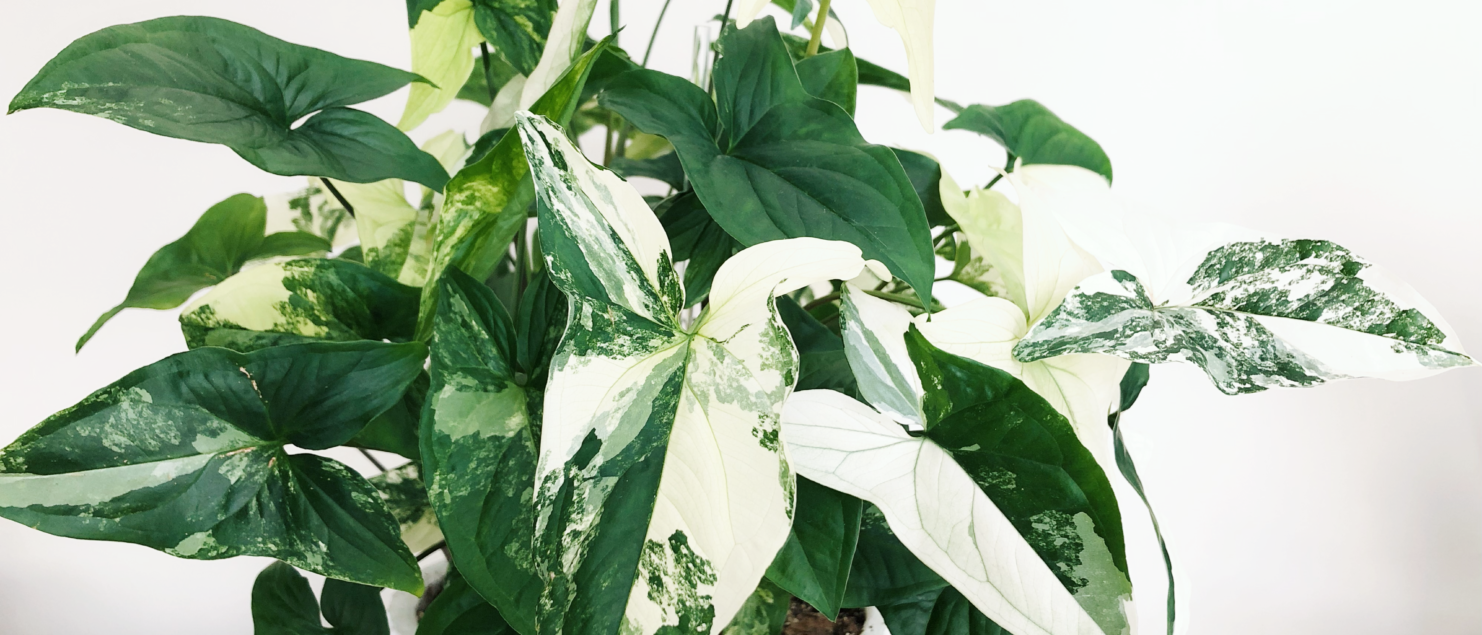Syngonium Albo Care Guide
There’s no doubt that the Syngonium Podophyllum Albo-Variegatum is one of the prettiest plants on the market today. The once hard to find and pricey beauty is becoming more easier to obtain than ever.
This could be due to the ease of care these plants have or the fact that they grow like weeds (actually, some people believe these to be weeds). But nonetheless, these plants are perfect for the person who wants to add a variegated plant into their collection – without the headache.
Here’s some care tips and tricks on how I keep my Syngonium Albo happy and healthy.
The Weed Of The Forest
Before we get into Syngonium Albo care in the home, lets better understand how these survive in the wild.
The Syngonium Podophyllum is native to areas in Central and South America. So, you can already tell that they prefer a warmer climate. Syngoniums grow very quickly, they’re vining plants, so they like to attach themselves to trees – or really any type of natural surface they can climb on. In the wild they creep along the forest floor until they find a nice tree to attach its aerial roots into.
Over the years, areas like South Florida are noticing an increased amount of Syngoniums growing in the wild. Many plant enthusiasts and horticulturists have introduced this plant throughout the years, and experts are starting to pick up on the havoc these beauties wreak on the native forests.
Due to them being climbers, there stems, and aerial roots are much stronger than some other native climbers in the forest. Which means, they often steamroll other plants and cause damage to them. Syngoniums have also been known to snap smaller trees due to the heavyweight they add to them.
It’s has got so bad in Florida that they ask you to destroy any Syngoniums you may have growing wild on your property – yikes!
Environmental Impact For Your Houseplant
Keeping Syngoniums in your home is perfectly fine and pose no environmental threat.

When they’re kept in pots inside the home, they are – well, contained. Often (like any plant) you may need to prune your Syngonium. Make sure that all clippings and discarded into sealed plastic bags – like a garbage bag. This will help so they won’t overtake any landfills.
Behaviors & Characteristics
Growth Patterns
The Syngoniums Albo will grow in your home as they would in the wild. Giving your Syngonium a moss pole or a board to climb will help it grow stronger and produce bigger and more lush foliage.
They can also be trained to trail, as well. When your Syngonium starts to trail, it’s basically looking for something to grab onto. Placing your plant on a shelf and letting it climb down will be just as good for it, as it would climbing up.
Foliage
There’s no doubt that the Syngonium Albo has some of the most striking foliage of all variegated plants. Each leaf will possess a new and different variegation pattern – some will have white and green marbling, some could be either all white or all green, and some can have half and half (half-moon).

A mature Syngonium will have a different foliage shape that looks like an upside down 5-point star.
Variegation in the Syngonium Albo is not stable, meaning the variegation could go away with each greener leaf. To bring back the variegation in the foliage snip off any completely green leaves until the variegated ones, and make sure your Albo is in a well-lit room.
*The green leaves can be propagated to create a green version that’s just as pretty.
Syngonium Albo Care
Watering & Fertilizing
Your Syngonium Albo will appreciate a good watering every 7-12 days on average. Your watering frequency will depend on your lighting and air flow where the plant lives.

Make sure you check the soil with a moisture meter before watering. I’ve found that this plant is more tolerant to being wetter than dry – but be careful not to overwater. Water your Syngonium thoroughly on top until the water drips out of the bottom.
Fertilize your Albo (with a balanced NPK fertilizer) 2-3 times a month, in the spring and summer months. In the fall and winter, slow it down to once a month.
Lighting
An all green Syngonium will do perfectly fine in a medium to even a low-lit setting. But an Albo needs it brighter. Make sure your plant gets bright indirect light for most of the day. Mine in by a Southeast window and gets dappled morning sun, which fades into bright light by early afternoon.

Your Albo could lose some variegation if kept in a lower lit setting.
Temperature & Humidity
Best rule of thumb is: if you’re comfortable your plants are too. If it’s too cold, your Syngonium is most likely cold, as well. Keep the temperature at between 60-80 degrees.
These tropical plants prefer a higher humidity – but I’ve found that normal home (30-50%) humidity is just fine. In the winter, I’d suggest giving your Syngonium an increased amount of humidity by placing a humidifier near your plant.
Soil Mixture
Your Syngonium will be happiest in a loamy well-draining soil. I use Fox Farm Ocean Forest soil with lots of perlite (for added drainage) and coco coir (to hold moisture). You want a loose soil to avoid root rotting.
Common Problems & Toxicity
Syngoniums like more water due to their tropical nature, but with that could come root rotting. Yellowing and drooping leaves are all a sign that your Syngonium might be struggling with rot.
Here’s how to fix root rot if you are experiencing this
Syngoniums are spider mite MAGNETS! They do attract other pests like mealybugs and aphids, but spider mites are the worst for these Albos.
Like most tropical plants, Syngoniums are mildly toxic to pets and humans. If ingested or chewed, symptoms could include salivation, a tingling or burning sensation in and around the mouth, tongue, and throat, could also be accompanied by swelling.
Propagation
Take a cutting 2 inches below the node and place it in your desired propagation media.

Here’s a complete guide on how to propagate plants: Click here.
Looks Can Be Deceiving
Syngoniums Albos make for a beautiful houseplant. Taking care of a Syngonium Albo couldn’t be easier. Which makes this a variegated and “rarer” plant a good option for a beginner plant parent.
These little angelic plants are nice inside, but let them run wild outside and they become little terrors to other native plants.


